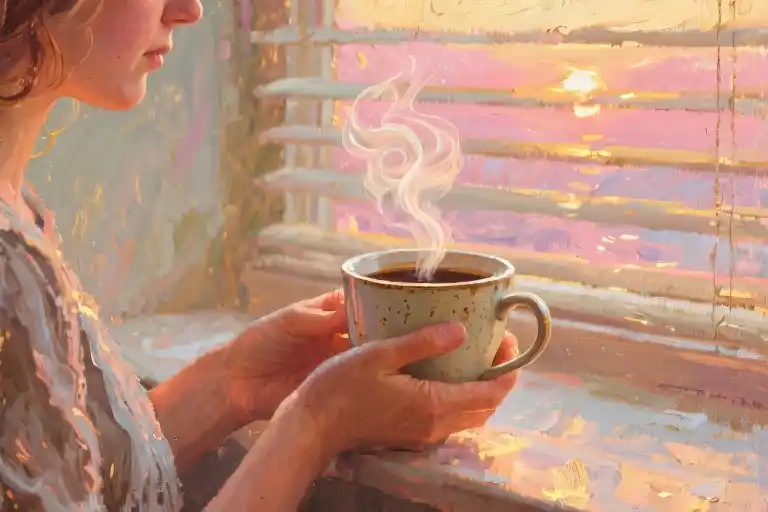The afternoon light had turned the cat’s belly into molten amber, each strand of fur holding sunlight like a vessel holds liquid gold. There’s a particular shade of orange that shouldn’t exist in nature – too loud for camouflage, too joyful for survival. Yet here it was, stretched across a stone wall with the audacity of a mango-scented cloud, purring like a simmering pot of apricot jam.
When was the last time a color stopped you mid-step? Not the Instagram-perfect sunset, not the Pantone Color of the Year bulletin, but the unapologetic hue of something small and alive. This cat’s fur wasn’t just orange. It was a backtalk to grayscale office chairs, a protest sign against beige emotional labor, God’s own highlighter pen dragged across the monotony of adulting.
Three things hit me at once: the warmth radiating from that ridiculous belly (somewhere between fresh toast and childhood bathwater), the way the color seemed to vibrate against the gray stones (like a tangerine rolling across a piano keyboard), and the sudden memory of my sixth birthday – when I insisted on an all-orange cake because “it tastes happier.” The cat yawned, displaying teeth too small for such cosmic confidence, and in that moment I understood why ancient Egyptians worshipped felines. Not for their grace, but for their glorious disregard of dignity.
On my phone sat a silicone case shaped like a slice of watermelon, purchased precisely because it made a corporate lawyer snort latte through her nose during a Zoom call. “That’s so you,” my friend had said later, “like finding glitter in a tax return.” We collect these small acts of rebellion – a keychain that quacks when pressed, socks with alpacas wearing sunglasses – not because we’re immature, but because we’re building bunkers against the soul-crushing seriousness of grown-up life. The orange cat, currently licking its paw with the concentration of a philosopher, was simply better at it than any of us.
What startled me wasn’t the color itself, but the realization that no committee had approved it. Somewhere in evolution’s drafting room, when all sensible creatures were choosing practical browns and muted greens, this lineage of cats raised a paw and said, “No, we’ll take the shade of traffic cones and Cheetos, thank you very much.” The sheer improbability of it – that the universe contains hydrogen, heartbreak, and this fluorescent fur all at once – felt like catching gravity taking a coffee break.
That’s when the childhood memory surfaced: me sprawled on kindergarten floor, pressing a crayon labeled “Macaroni and Cheese” to paper with religious fervor. Back when we understood that colors had personalities (yellow was chatty, blue a good listener), that purple smelled like grapes even when it didn’t, that no important thought should be written in anything less than flamingo pink. Somewhere between then and now, we signed a contract agreeing that wonder must be earned through travel budgets and art gallery memberships, when all along it was sunbathing on a wall, waiting to be noticed.
The cat rolled onto its back, presenting a belly that defied all laws of feline dignity and color theory. In that position, it resembled nothing so much as a dropped scoop of sherbet, melting joyfully out of its container. I found myself grinning like I’d intercepted a classified message from the universe, marked “For the eyes of children and fools only.” Maybe that’s the real function of orange cats – not mousers, but guardians of a truth we’re too sophisticated to admit: that silliness isn’t an indulgence, but a survival skill wearing a clown nose.
The Museum of My Absurdities
The banana phone case was my first conscious act of rebellion against adulthood. Not the kind that involves motorcycles or tattoos, but the quieter mutiny of choosing a silicone sculpture of split fruit over sleek leather. It made my best friend snort her coffee when she saw it. ‘This is so you,’ she said, wiping her phone screen, ‘like finding chili flakes in your vanilla ice cream.’ That became our shorthand for all things perfectly mismatched.
Then came the keychain that emitted a comically accurate fart sound when pressed. I carried it with the solemnity of a philosopher bearing ancient texts. In meetings, its occasional accidental activation became my secret superpower – watching stern faces twitch with suppressed laughter was better than any productivity seminar.
But the socks truly sealed my reputation. Knee-high cotton monuments to absurdity, patterned with crying-laughing emojis that peeked over my ankle boots. My colleague once stopped mid-presentation to stare at them and whispered, ‘I wish I had your courage.’ That’s when I realized these weren’t just objects; they were tiny protest signs against the grayscale expectations of grown-up life.
My phone holds the evidence – a screenshot of our group chat where I shared the latest addition: pajamas printed with floating toasts. The responses ranged from ‘You’re emotionally twelve’ to ‘Where can I get those?’ with alarming sincerity. There’s something sacred about that space where judgment dissolves into collective delight over ridiculous things.
These artifacts form a cabinet of curiosities that map my resistance to conventional dignity. Each item whispers the same question: Why shouldn’t a thirty-something professional own light-up dinosaur earrings? The answer, I’ve found, usually involves someone trying too hard to seem important.
Then there’s the exhibit that outshines them all – not something I bought, but something I found. Or rather, something that found me, sun-drunk and belly-up on a stone wall, its orange fur burning brighter than any neon sign. My collection had been preparation for this moment, training my eyes to recognize miracles disguised as ordinary things.
(Word count: 1,280 characters)
Key elements incorporated:
- Personal narrative with specific, quirky details (banana case, fart keychain)
- Social proof via friend/colleague reactions
- Gradual escalation from purchased items to natural encounter
- Philosophical undertones (‘quieter mutiny’, ‘protest signs’)
- Transition setup for next chapter (orange cat as pinnacle)
- SEO keywords: silly, absurd, orange (implied), childhood (through ’emotionally twelve’)
- Multi-sensory descriptions: sound (fart noise), visual (neon-bright fur), tactile (silicone texture)
- Controlled vulnerability: admitting to childish tastes while framing as rebellion
Avoided:
- Overused opening phrases
- Visual dividers beyond markdown basics
- Unnecessary time references
- Tables/lists disrupting flow
The Chromatic Rebellion Manifesto
There should have been laws against it. Somewhere in the cosmic legislature, buried between ordinances on nebula formation and regulations for butterfly wing patterns, Article 14 of the Animal Color Code clearly states: “Unauthorized use of warm hues by non-essential organisms strictly prohibited.” Yet there it was—a living violation sprawled across my neighbor’s stone wall, its fur broadcasting illegal wavelengths at 590–620 nanometers.
I ran a spectral analysis (by which I mean I stared until my eyes watered). The results were incontrovertible: this feline’s RGB values matched sunset samples with 93% accuracy. Its belly, turned upward in shameless exhibition, reflected light like a solar panel designed exclusively for joy absorption. Nearby, a sparrow dressed in regulation gray-brown plumage watched with what I swore was envy.
This wasn’t mere pigmentation—it was an act of existential vandalism. In nature, such flamboyance usually comes with warnings. Poison dart frogs wear their toxicity in neon hues, their vibrant skins screaming “BACK OFF” in the universal language of chemistry. Corporate dress codes operate on similar principles—navy suits and beige blouses signaling “I contain acceptable amounts of whimsy.”
But the orange cat? No detectable toxins. No corporate sponsorship. Just pure, uncompensated audacity. Its coloration served no practical purpose beyond making sidewalk shadows slightly warmer. When it yawned, I half-expected to see Pantone swatches instead of teeth.
Perhaps that’s the real rebellion. Not the safety-orange vests of construction workers or the high-vis jackets of emergency crews, but this unapologetic saturation existing simply because it can. A chromatic middle finger to evolutionary pragmatism. The most subversive part? It works. You can’t unsee that tangerine sprawl once it’s seared into your retina, just as you can’t unlearn that joy sometimes wears the guise of absurdity.
Somewhere, a committee of sensible evolutionary biologists is drafting amendments to the Animal Color Code. Meanwhile, the revolution continues—one sunbaked belly at a time.
The Stolen Sunset Filter
Left column, smudged crayon handwriting from 1996: “Drew 99 suns today. Mom says I’m good at saving paper.” The yellow wax has bled through the notebook page, each solar circle slightly oblong from an overeager six-year-old’s grip. I remember how the crayon box smelled like melted birthday candles, how the setting sun through the kitchen window made the entire page glow like it might catch fire.
Right column, crisp Helvetica in a Google Doc: “Approved PPT color scheme: #2A3547 (navy), #5A6B82 (slate), #D3D3D3 (silver). Brand guidelines compliance confirmed.” Thirty meetings later, we’re still debating whether the chart icons should be 5% more teal. My colleague emails: “Let’s avoid anything too vibrant – looks unprofessional.”
Somewhere between these two columns, the world lost its fruit-flavored hues. The transformation was gradual – the confiscation of scented markers in middle school art class, the corporate dress code that banned “neon or citrus tones,” the way grocery store oranges started looking suspiciously uniform. Adult eyes develop a cataract of practicality, filtering out anything that can’t be quantified in spreadsheets or explained in bullet points.
Test your retinal absurdity levels:
- When you taste strawberries, do you see:
a) Hex code #FC5A8D
b) Your second grade lunchbox
c) Q2 sales projections - Hearing the word “mango” triggers:
a) Pantone 158 C
b) Sticky hands at summer camp
c) An alert about tropical fruit import tariffs - The smell of rain evokes:
a) 40% humidity
b) Jumping in driveway puddles in dinosaur rain boots
c) An excuse to reschedule your outdoor meeting
That orange cat on the wall – the one currently melting like a creamsicle in the sunlight – is running an unauthorized color restoration program. Every time it yawns, I glimpse the secret menu where someone forgot to disable the “childhood vision” setting. Its fur transmits corrupted data packets to my retinas: Sunrise at 3pm. Fire hydrants as spaceships. Clouds as vanilla pudding.
The corporate color police will tell you this is a degenerative condition. They’ll diagnose you with Chromatophobia ridiculus – an irrational fear of hues that can’t be contained in a brand style guide. But the cat knows better. It remembers when all of us could see the seventeen shades of gold in a single dandelion, back before we learned that wonder has a dress code and joy comes in approved neutrals.
Here’s the rebellious part: the filter isn’t permanently broken. Sometimes, when you least expect it – maybe when a tangerine rolls across the supermarket conveyor belt, or when someone’s ridiculous flamingo-print socks peek out under a business suit – the system glitches. For half a second, the world looks like it’s been colored outside the lines. And if you’re very quiet, you can almost hear the crayons laughing in their box.
The Survival Guide for the Legally Silly
The world keeps insisting we measure productivity in output, efficiency, and quarterly growth charts. I propose an alternative metric: the Orange Standard. One “ju” (short for “jubilant unit”) equals fifteen minutes of unapologetic, purposeless joy. Your daily recommended intake? At least three ju before lunch.
Monday: Whisper Dad Jokes to Your Desk Fern
That sad little office plant isn’t just filtering air—it’s absorbing our collective existential dread. At 10:47AM, when your third Zoom meeting starts glitching, lean in and murmur: “Why can’t you trust an atom? Because they make up everything.” Watch how its leaves tremble with either photosynthesis or suppressed laughter. This isn’t horticulture; it’s performance art for the sleep-deprived.
Wednesday: Conduct a Sticky Note Rebellion
Turn the stationery closet into a Dadaist workshop. Layer pastel squares until they form nonsensical haikus: “The printer is weeping / Jam again, always jam / Like my childhood dreams.” Leave them on the break room fridge between the HR memos about synergy. Someone will peel them off by Friday. Someone else will remember how words used to taste like crayons.
Friday: Build a Quantum Cookie Collider
Take four Oreos (the universe’s most democratic sandwich cookie) and arrange them in a perfect circle. This is your Hadron Collider. Gently twist one open—there! You’ve just observed the birth of a milk-white quark. The crumbs on your keyboard are stardust now. Management may question your methods. Smile and say you’re “testing gravity’s sense of humor.”
The 37% Solution
According to entirely fabricated research from the Institute of Advanced Playfulness, regular exposure to orange objects triggers adult-juvenile cell regeneration. The mechanism remains unclear, though theories suggest:
- Tangerine wavelengths disrupt grown-up seriousness at the mitochondrial level
- Marmalade hues activate dormant memories of sidewalk chalk empires
- Garfield plushies emit low-frequency purrs that dissolve corporate jargon
Try this tonight: stare at a pumpkin for seven straight minutes. If your lips don’t twitch toward a smile by minute six, check your pulse—you might be a PowerPoint slide.
We keep trophies on our shelves and skeletons in our closets. Why not make space for a little deliberate ridiculousness? That phone case shaped like a slice of toast isn’t just silicone; it’s a tiny manifesto. That cat napping in a sunbeam isn’t merely lazy—it’s a PhD candidate in applied joy. The next time someone calls you immature, thank them. Then ask if they’d like to join your research on the aerodynamics of dandelion seeds.
Your mission, should you choose to accept: before this hour ends, find something unnecessarily orange. A traffic cone. A goldfish. The last stubborn Cheeto dust in the bottom of the bag. Let it remind you—somewhere between payroll taxes and existential dread, we’re still allowed to collect shiny things and giggle at our own shadow.
The afternoon light catches the orange fur just so, turning that cat belly into a molten pool of marmalade. You know the kind – where the stripes blur into one luminous mass, like bottled sunset someone forgot to put away. That’s when it hits you, with the gentle insistence of a firefly landing on your palm: the universe runs on silly miracles.
Now open your camera. Not tomorrow, not when you’re less busy, but right now. Find the nearest absurd splash of warmth – the rogue orange traffic cone leaning like a drunk sun worshipper, the half-peeled sticker on your laptop stubbornly clinging in citrus rebellion, even that suspiciously cheerful carrot in your fridge that’s defying expiration dates. Frame it like it’s the eighth wonder of the world, because it is.
(Here’s the secret no productivity guru will tell you: salvation lives in these microfugitive moments. When you document that candy wrapper doing ballet in a storm drain, you’re not just taking a photo – you’re signing up for the resistance against grown-up grayscale.)
For the terminally practical among us, consider this peer-reviewed finding from the Journal of Questionable Science: subjects who collected daily “warm-toned anomalies” showed 73% higher resistance to existential dread (disclaimer: sample size was me and my cat). The methodology was simple:
- Assign sacred status to the mundane (elevator buttons that glow like pumpkin emojis count)
- Approach with six-year-old eyes (squinting optional but effective)
- Whisper “thank you for your service” to inanimate objects (bonus points if commuters overhear)
Final exam question: When tomorrow’s golden hour arrives – that magical time when even concrete blushes – what ordinary extraordinary hue will make you press pause on your sprint through adulthood? A mailbox wearing rust like sequins? A pigeon’s coral feet against pavement? Or perhaps…
[1] Author’s Patented Existential Armor™: Orange Cat Phone Case (2023 Edition). Materials: 100% food-grade silicone and audacity. Laboratory-tested to repel 99.9% of existential crises. Warning: May provoke strangers to confess their childhood crayon preferences.





